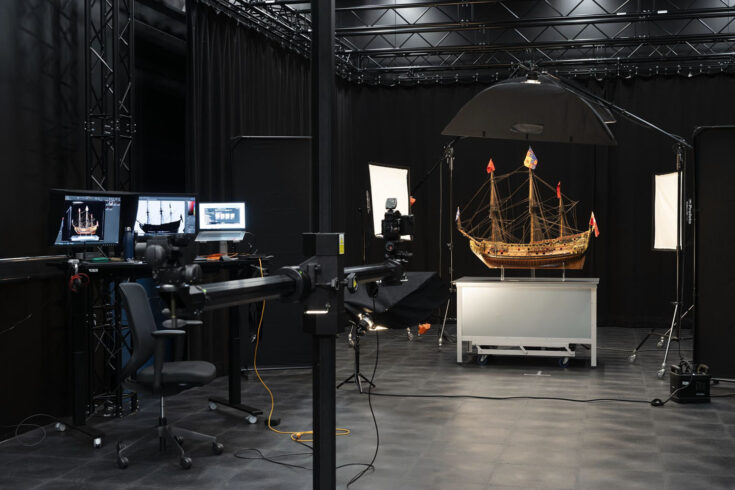A £3 million investment to support a world-class isotope facility at Queen’s University Belfast. £1 million to create immersive experiences at Historic Environment Scotland. £1.9 million to upgrade a pioneering music performance laboratory at the Royal College of Music. £1 million for a suite of battery-operated flash units to capture complex images of the Science Museum Group’s collections.
These are just a handful of examples of the Arts and Humanities Research Council’s (AHRC’s) World Class Labs (WCL) projects.
This week AHRC publishes the evaluation report which demonstrates the remarkable impact these investments have had in upgrading the UK’s creative and heritage facilities.
To mark this important milestone, I reflect on how funding for cutting-edge facilities, equipment and resources has transformed the arts and humanities research landscape and what opportunities the future holds.
How it began…
In 2020, UK Research and Innovation (UKRI) launched the WCL Fund. This was a multi-year programme designed to enable research organisations to maintain and improve facilities, and provide UK researchers with access to world-class laboratories, equipment, digital resources and the expertise that make them work. The initial tranche of funding was part of a £300 million investment in world-class research infrastructure announced by the government in July 2020.
WCL created an exciting new funding mechanism for AHRC. The programme recognised the importance to our community of environmentally controlled storage for unique but fragile collections. It supported studios and spaces for creative research and development; and injected funding into cutting-edge scientific instruments to inform our understanding of our heritage assets.
AHRC used the opportunity to consider how significant capital investment into these services and structures could underpin, enable and inspire every aspect of arts and humanities research.
Upgrading the UK’s heritage science
In 2020, AHRC launched its first capital funding opportunity, Capability for Collections (CapCo). This enabled us to make a series of targeted investments to renew and upgrade facilities and equipment for access, preservation, study and analysis of cultural heritage collections.
CapCo was truly transformative. In all, 62 awards totalling £37 million were made to research organisations across all four nations of the UK. An early beneficiary was Queens University Belfast, whose 14CHRONO facility received a £3 million grant.
As well as providing new analytical capability for Northern Ireland and the Republic, the grant supported expansion of the facility’s remit beyond environmental sciences into archaeological science and collections-focused research. It also has subsequently leveraged further support.
Supporting the UK’s creative economy and soft power
AHRC further expanded its portfolio in 2022 with the launch of the Creative Research Capability (CResCa) fund. CResCa was specifically designed to support the research and innovation capabilities of our small, specialist institutions (SSIs). These include conservatoires, the School of Oriental and African Studies, the Courtauld Institute, the Royal College of Art, and the colleges of the University of the Arts London.
Highly specialist and internationally renowned for excellence, these institutions help produce the talent that ensures the UK’s creative economy remains globally competitive. But to remain world-class, these SSIs require custom-built, state-of-the-art technology for teaching, research and innovation.
Through CResCa, AHRC made 23 awards with a total value of £25.5 million. Projects ranged from medium-scale equipment upgrades to funding major new facilities.
For example, Historic Environment Scotland (HES) were awarded £1 million to expand their digital capabilities and immersive experience offer. This investment has engaged with and highlighted the plight of refugee communities, and raised awareness of responsible tourism, in alignment with HES’s climate action plan.
Video credit: AHRC
Video transcript and on-screen captions are available by watching on YouTube.
The Royal College of Music received funding of £1.9 million to upgrade and expand its pioneering Performance Simulator facility. Investment facilitated creation of a state-of-the-art 110-capacity accessible studio and new simulation and performance-capture system. This enables performers to practise in real-world, dynamic performance conditions with reactive virtual audiences and audition panels.
The simulator has not only benefitted the college and its students but has been used as a training facility across industry and government, to include Imperial College London’s Executive MBA students, coaches at the Football Association, athletes, tech executives, entrepreneurs and civil servants.
View the Instagram post: behind the scenes of a performance simulator.
A measure of difference
In November 2023, AHRC commissioned Technopolis and BOP Consulting to undertake an independent impact evaluation of our WCLs programmes. The brief was to evaluate and assess the extent to which WCL has made an impact on research, skills, partnerships and collaborations, and innovation. AHRC has been strongly encouraged by the responses our community generously provided for the evaluation, which show a fantastic range and breadth of benefits, including:
- 83% of surveyed grant holders reporting research-related benefits, with 54% reporting that their grants had resulted in additional funding
- over 66% of surveyed grant holders reporting skills and training benefits, including the recruitment of 58 full-time equivalent posts, and training for 959 staff members
- over 66% of surveyed grant holders reporting their grant had enabled new partnerships and strengthened those already in place, with 649 new national partnerships reported, and five international
- respondents also reported a range of innovation and economic benefits, including efficiencies and improved productivity, new commercial contracts and co-investment, and significant annual savings
Where next?
As AHRC looks back on five years of transformation, we are also looking ahead.
Much has been achieved, world firsts are:
- the Research Infrastructure for Conservation and Heritage Science, our £80 million investment in a national infrastructure for heritage science
- the Convergent screen technologies and performance in realtime, the £75.6 million investment in a national network for screen and performance technologies
The WCL investment has materially transformed the arts and humanities research landscape. But much remains to be done.
Going forward, our priorities are to ensure that investment in arts and humanities research infrastructure becomes a fixture in the research, development and innovation landscape. Our priorities are to also ensure that our communities can access the resources they require to respond to the major challenges of our time.
We want to ensure UK researchers are able to engage internationally to maximise the impact of their work and forge new collaborations. And we want to enable access to the tools and technologies used by researchers for capture, analysis and visualisation of data.
AHRC is grateful to all who contributed to the WCLs programme and the wider work to build the facilities, laboratories, resources and equipment needed to undertake ground-breaking work. Our community continues to be our inspiration and we look forward to working with you on the next exciting stage of this journey.
Read the evaluation report: evaluation of AHRC’s World Class Labs portfolio.




